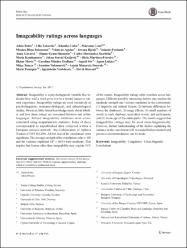| dc.contributor.author | Rofes, Adria | |
| dc.contributor.author | Zakarias, Lilla | |
| dc.contributor.author | Ceder, Klaudia | |
| dc.contributor.author | Lind, Marianne | |
| dc.contributor.author | Johansson, Monica Blom | |
| dc.contributor.author | de Aguiar, Vania | |
| dc.contributor.author | Varlokosta, Spyridoula | |
| dc.date.accessioned | 2019-10-22T20:06:54Z | |
| dc.date.available | 2019-10-22T20:06:54Z | |
| dc.date.issued | 2018 | |
| dc.identifier.issn | 1554-351X | |
| dc.identifier.issn | 1554-3528 | |
| dc.identifier.uri | https://dx.doi.org/10.3758/s13428-017-0936-0 | |
| dc.identifier.uri | https://hdl.handle.net/11421/22114 | |
| dc.description | WOS: 000434639400023 | en_US |
| dc.description.abstract | Imageability is a psycholinguistic variable that indicates how well a word gives rise to a mental image or sensory experience. Imageability ratings are used extensively in psycholinguistic, neuropsychological, and aphasiological studies. However, little formal knowledge exists about whether and how these ratings are associated between and within languages. Fifteen imageability databases were cross-correlated using nonparametric statistics. Some of these corresponded to unpublished data collected within a European research network-the Collaboration of Aphasia Trialists (COST IS1208). All but four of the correlations were significant. The average strength of the correlations (rho = .68) and the variance explained (R (2) = 46%) were moderate. This implies that factors other than imageability may explain 54% of the results. Imageability ratings often correlate across languages. Different possibly interacting factors may explain the moderate strength and variance explained in the correlations: (1) linguistic and cultural factors; (2) intrinsic differences between the databases; (3) range effects; (4) small numbers of words in each database, equivalent words, and participants; and (5) mean age of the participants. The results suggest that imageability ratings may be used cross-linguistically. However, further understanding of the factors explaining the variance in the correlations will be needed before research and practical recommendations can be made. | en_US |
| dc.description.sponsorship | European Cooperation in Science and Technology (COST, Action) [IS1208]; Global Brain Health Institute; Basque team; Basque Government [IT983-16-GIC 15/129]; MINECO/FEDER [FFI2015-68589-C2-1-P]; Research Council of Norway [223265]; Croatian Science Foundation; project "Adult Language Processing" (ALP) [HRZZ-2421-UIP-11-2013]; Ministry of Education Science and Technological [IO175012]; Anadolu University, Scientific Research Project (BAP) [1509S632]; PROGRAM (University of Copenhagen Excellence Programme for Interdisciplinary Research); Ministerio de Economia y Competitividad [FFI2015-68589-C2-1-P, FFI2014-61888-EXP]; [FFI2014-56968-C4-1-P] | en_US |
| dc.description.sponsorship | The Collaboration of Aphasia Trialists (CATs research network) is funded by the European Cooperation in Science and Technology (COST, Action IS1208). For more information, please visit www.aphasiatrials.org. This project was partially supported by the Global Brain Health Institute (A.R.). The Basque team (A.M.I. and M.P.) was partially supported by the Basque Government (Grant No. IT983-16-GIC 15/129) and MINECO/FEDER (FFI2015-68589-C2-1-P). The work by the authors from Norway (M.L. and H.G.S.) was partly supported by the Research Council of Norway through its Centres of Excellence funding scheme (223265). The Croatian study (J.K.K.) was supported by the Croatian Science Foundation and the project "Adult Language Processing" (ALP, Grant HRZZ-2421-UIP-11-2013). The Catalan study (A.G.) was supported by project FFI2014-56968-C4-1-P. The Serbian study (J.B. and J.V.) was supported by the Ministry of Education Science and Technological development grant (#IO175012). The Turkish study (I.M. and M.T.) was supported by Anadolu University, Scientific Research Project (BAP) Grant 1509S632. The Spanish study (S.M.-F.) was partly supported by PROGRAM (University of Copenhagen Excellence Programme for Interdisciplinary Research) and projects from the Ministerio de Economia y Competitividad (FFI2015-68589-C2-1-P and FFI2014-61888-EXP) The Greek group thanks Sophia Apostolopoulou and Michaela Nerantzini for their contribution to data collection. | en_US |
| dc.language.iso | eng | en_US |
| dc.publisher | Springer | en_US |
| dc.relation.isversionof | 10.3758/s13428-017-0936-0 | en_US |
| dc.rights | info:eu-repo/semantics/openAccess | en_US |
| dc.subject | Imageability | en_US |
| dc.subject | Linguistics | en_US |
| dc.subject | Cross-Linguistic | en_US |
| dc.subject | Correlations | en_US |
| dc.title | Imageability ratings across languages | en_US |
| dc.type | article | en_US |
| dc.relation.journal | Behavior Research Methods | en_US |
| dc.contributor.department | Anadolu Üniversitesi, Sağlık Bilimleri Fakültesi, Dil ve Konuşma Terapisi Bölümü | en_US |
| dc.identifier.volume | 50 | en_US |
| dc.identifier.issue | 3 | en_US |
| dc.identifier.startpage | 1187 | en_US |
| dc.identifier.endpage | 1197 | en_US |
| dc.relation.publicationcategory | Makale - Uluslararası Hakemli Dergi - Kurum Öğretim Elemanı | en_US] |


















